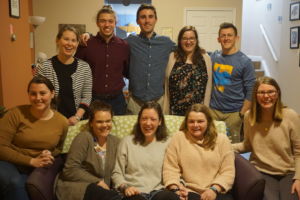Jonah Cremin-Endes, A Graduate of the University of Notre Dame
BSVM 2018-2019
Childhood and Community
Jean Vanier writes in Community and Growth, “All of us have a secret desire to be seen as saints, heroes, martyrs. We are afraid to be children, to be ourselves.” This juxtaposition aptly depicts my transition from an undergraduate student going full steam ahead along a career and goal oriented academic track as compared to a new graduate being present in community. A desire to be seen as a saint, hero, or martyr is expected as is the drive to move forward within ones career path. While this drive is not inherently wrong, the counter—being honest with the child like nature we all hold—is paramount for development of community which in turn allows us to truly become who we are.
The desire to be revered is comfortable because it is supported by the world we live in. Our actions are affirmed when they are deemed “good” by others. Those who consistently fall in this category are seen as heroes. But living in community is in itself a challenge to the society that we are present in. Rather than looking outward for ways in which we can move closer to who we perceive we should be, community challenges us to look inward where we can move towards who we truly are. This true identity as pointed out by Vanier is most clearly seen in childhood.
Fittingly, one experience through which I felt our community grow in depth took place in a location usually reserved for children, the floor. The transition to the floor took place after family dinner. The conversation around the table slowed until it was injected with one short phrase “tummy circle?” One nod, then another, then another. Everyone at the table was in agreement as we jumped up out of our chairs and hopped on to the ground. With a juvenile spirit we placed ourselves in a circle with each person resting their head on another’s stomach while someone else was resting a head on theirs. With the tummies properly prepared all we had to do was wait. “What now?” was spoken by one of the supported heads and we were off. A slight chuckle was emitted. The subtle laugh rooted in the hearth was felt by the next member of the circle as their pillow (the moving tummy) shifted, prompting laughter from them as well. Soon the circle was a whirlpool of laughter. This joy was produced through the unison of everyone in the community as we embraced our inner childlike nature.
Further reflection on this moment reveals it is a microcosm for the lessons of community. We lowered ourselves to the ground, an act of humbling ourselves. While adult post meal conversations typically take place at the table, community allows for the metaphorical table to take many forms. The tummy circle form brought together five individuals through laughter. This laughter was not rooted in an exterior show or performance but rather our own humanity, specifically our childlike nature. Through being ourselves we already brought everything that was needed to the table.
As Vanier alludes to, it is frightening to see oneself honestly; to see oneself as a child. We would rather forget our flaws and follow the path that the world pushes us towards. Community is a radical challenge to this path. Like stepping off of a treadmill, it feels uncommon and perhaps uncomfortable at first. But this act of stepping off, leaving behind our desire to see ourselves as heroes and instead fostering community, ignites our ability to live out our true calling through embracing our childlike nature.

